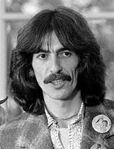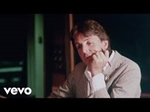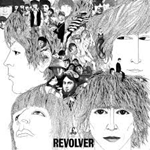- Register
- Log in to Tune-In
- Wishlist (0)
-
Shopping cart
(0)
You have no items in your shopping cart.
Beatles News

Seth Rogovoy’s "Within You Without You" sheds new light on George Harrison’s pivotal contributions to The Beatles
George Harrison of English rock and pop group The Beatles, wearing sunglasses and a denim jacket, takes part in filming of the television musical film 'Magical Mystery Tour' at Newquay in Cornwall on 13th September 1967. (David Redfern/Redferns/Getty Images)
When it comes to the so-called Quiet Beatle, author Seth Rogovoy’s "Within You Without You: Listening to George Harrison" accomplishes a rare feat. In a sea of ineffectual biographies devoted to the Beatles’ guitarist, Rogovoy makes a case for Harrison’s most important contribution: the music itself.
A self-described amateur guitarist, Rogovoy draws upon his musical skills to deliver a powerful new reading of Harrison’s role in fueling one Lennon-McCartney classic after another. Rogovoy offers a careful delineation of the mottos, riffs, and licks via which Harrison left a distinctive imprint upon the Beatles’ sound, from early hits such as “Please Please Me” and “She Loves You” through "Abbey Road" and the group’s twilight years.
As Rogovoy astutely writ details

After The Beatles broke up, Paul McCartney began touring for the first time in years with his band Wings. The Beatles stopped touring in 1966, so many people hoped to hear McCartney perform them live with Wings. He shared why he decided not to do that on their first tour, even though it complicated things for him.
Paul McCartney didn’t want to play Beatles songs on his 1st tour with Wings
McCartney went years without touring, so he admitted he was “very nervous” ahead of his first concert dates with Wings.
“The main thing I didn’t want to face was the torment of five rows of press people with little pads all looking and saying, ‘Oh, well, he’s not as good as he was.’ So we decided to go out on that university tour, which made me less nervous because it was less of a big deal,” he told Rolling Stone.
Source: imdb.com
details
A recording of a "long-lost" interview given by The Beatles for a feature in Playboy magazine is set to be auctioned.
The two hour interview, carried out by American journalist and radio host Jean Shepherd, took place in October 1964 after a concert at the Exeter ABC.
The cassette tapes are said to include "unfiltered moments" such as Paul McCartney swearing about a hostile journalist and 15 minutes of live concert recordings.
The tapes will be auctioned by Merseyside based Omega Auctions on 15 October, with a price-tag starting at £10,000.
The recordings include "heartfelt anecdotes" from John Lennon and McCartney about their families, as well as "playful banter".
Omega said that while the interview provided the basis of a feature that appeared in Playboy in February 1965, the full tapes had never been published.
The recording begins with a spoken introduction by Shepherd while the band play songs including Can't Buy Me Love and I Wanna Be Your Man.
Shepherd then carries out an in-depth interview at a Torquay hotel where the band stayed after the concert.
Omega auction manager Dan Muscatelli-Hampson said: "Unearthing gems like these is always exciting details

The Paul McCartney catalog is dotted with many classic albums he’s released over a long stretch of time. And he’s done it by knowing how to sequence those records so they often start off with a bang.
In terms of his finest album-opening songs, it’s not surprising many of them coincide with some of the best LPs of his career. Here are our picks for the five finest Side 1, Track 1 songs in Paul McCartney’s illustrious career.
5. “Tug of War” from Tug of War (1982)
The pressure on McCartney to deliver with the Tug of War album was heightened. On the one hand, it marked his definitive return to a solo career after his decision to scuttle Wings. And it was also the first album after the death of John Lennon, which ensured that all eyes and ears would be on Macca. He rose to the occasion in a big way on this record, and it starts with the title track, a stately look at the differences that unnecessarily keep people and nations apart. McCartney reunited with Beatles’ producer George Martin on this album, and Martin’s firm hand guiding the tiller can be felt on his track.
4. “My Brave Face” from Flowers in the Dirt (1989)
This was another poin details

Paul McCartney did not play the Concert for Bangladesh when George Harrison asked. Here's why.
In 1971, George Harrison reached out across the rift separating the former members of The Beatles by inviting Paul McCartney to play in his Concert for Bangladesh. The benefit concert was among the first of its kind and raised money for refugees. McCartney admitted that when Harrison asked him to participate, he felt irritated.
After The Beatles broke up, Harrison and John Lennon publicly aired their grievances with McCartney. Still, Harrison asked him to take part in the benefit concert. McCartney declined, not wanting to reunite the band so soon after breaking up.
“George invited me, and I must say [my reason for declining] was more than just visa problems,” McCartney told Rolling Stone. “At the time there was the whole Apple thing. When the Beatles broke up, at first I thought, ‘Right, broken up, no more messing with any of that.’ George came up and asked if I wanted to play Bangla Desh and I thought, blimey, what’s the point? We’re just broken up and we’re joining up again? It just seemed a bit crazy.”
He admitted he felt irritated th details

The Beatles were driven forwards by the partnership of John Lennon and Paul McCartney, two souls were often in sync, but could sometimes drive each other crazy. Take ‘Across The Universe’ – often lauded as one of the band’s finest moments, it’s beatific paean was given an arrangement that sparked John Lennon to call it “subconscious sabotage”.
The lyric itself is one of Lennon’s most beautiful. The opening phrase of “words spilling out into a paper cup” was sparked by unease in his marriage, the image itself coming to mind after an uncomfortable conversation with his first wife, Cynthia.
“I was lying next to my first wife in bed, you know, and I was irritated, and I was thinking. She must have been going on and on about something and she’d gone to sleep and I kept hearing these words over and over, flowing like an endless stream. I went downstairs and it turned into a sort of cosmic song rather than an irritated song… [The words] were purely inspirational and were given to me as boom! I don’t own it you know; it came through like that.”
The song was first recorded at Abbey Road in 1968, with the high notes famously details

Across the Fab Four’s entire extensive discography, only one Beatles song featured a female lead vocalist. Interestingly, the John Lennon composition was also inspired by a woman. However, the conversation that sparked the song certainly didn’t paint the woman, who was described by another witness as a “self-important, middle-aged American woman,” in the most flattering light.
Nevertheless, inspiration can come in the unlikeliest of places, and the Beatles’ 1968 track “The Continuing Story of Bungalow Bill,” from the group’s iconic white album, is certainly no exception. The Beatles were no strangers to bending the rules of gender, perspective, and even reality in general. From “She Said She Said” to “Octopus’ Garden,” the Fab Four proved how adept they were at adopting unique points of view for their compositions. But in “The Continuing Story of Bungalow Bill,” they outsourced their character perspectives to a woman already present in the studio: Yoko Ono.
John Lennon’s second wife sang one line alone before the late musician joined her to finish the rest of the verse. Maureen Starkey, drummer Ringo Starr details

Paul McCartney Once Agreed With John Lennon's Belief That The Beatles Were 'Crap'.
After The Beatles broke up, Paul McCartney and John Lennon didn’t have much to agree on. Lennon insulted McCartney’s solo music and they clashed endlessly over the band’s contractual agreements. Ultimately, these constant clashes made them agree on one thing. McCartney admitted that the bitterness in the aftermath of The Beatles’ breakup tainted his view of the band for a time.
Paul McCartney said he felt as negatively about The Beatles as John Lennon for a time.
After The Beatles broke up, Lennon often spoke derisively about the work they did together as a band. He dismissed some of the songs they released and said they were con artists. McCartney admitted that navigating the messy band dynamics after their breakup made him feel the same way, at least for a time.
Source: IMBD
details
In 1991, Eric Clapton convinced his friend George Harrison to play 12 dates in Japan with him, December 1-17, marking the second tour of Harrison’s solo career. A few months later, Harrison surprised fans again with his first show in England since the demise of the Beatles. On April 6, 1992, Harrison’s show at the Royal Albert Hall in London would become his final full-length concert.
The last time Harrison had toured before ’91 was in 1974, around the release of his fifth solo album Dark Horse, and though he wasn’t inclined to perform again, he was prompted to play London to support the political group the Natural Law Party, founded on the principles of transcendental meditation and affiliated with Maharishi Mahesh Yogi.
“I want a total change and not just a choice between left and right,” said Harrison in a press release to promote the show. “The system we have now is obsolete and not fulfilling the needs of the people. Times have changed and we need a new approach. The Natural Law Party is turning this election into a wonderful, national celebration and I am with them all the way.”
At first, Harrison was also hesitant about returning to the UK for a show details

Revolver marked a pivotal moment in The Beatles’ career, blending experimental sounds with groundbreaking studio techniques. Tracks like “Tomorrow Never Knows” and “I’m Only Sleeping” showcased the first use of backward guitar recording and automatic double tracking (ADT), pushing the boundaries of music – popular and otherwsise. From psychedelic rock to children’s tunes like “Yellow Submarine,” there really is something for everyone.
First Use of Backward Guitar Recording: Revolver features the first use of reversed guitar recordings in popular music, particularly on the song “I’m Only Sleeping.” George Harrison’s guitar solo was recorded, reversed, and then layered onto the track, giving it a dreamy, otherworldly sound.
First Use of Automatic Double Tracking (ADT): Engineer Ken Townsend at Abbey Road Studios developed ADT specifically for The Beatles during the Revolver sessions. This technique automatically doubled a vocal or instrumental track, creating a fuller sound without the need for manually recording multiple takes.
Source: thatericalper.com

This playlist with annotations that I have put together is not intended to be a “best-of” George Harrison (although all the songs here would easily be on such a playlist). Nor is it meant to be exclusive—one could easily devise a playlist with ten different “quintessential” George Harrison songs: one that would include “My Sweet Lord,” “It’s All Too Much,” “I Me Mine,” “Give Me Love (Give Me Peace on Earth),” “Blue Jay Way,” and, of course, “Something” and “Here Comes the Sun.”
Rather, these are ten songs that represent various aspects of George Harrison’s brilliance as a songwriter and recording artist. They tie together themes, concepts, and musical and lyrical approaches in a manner that represents some essential aspects of George’s genius and creativity.
1. Don’t Bother Me
Written while he was lying ill in a hotel bed in August 1963, “Don’t Bother Me” could well stand as a credo for George Harrison, an early manifesto capturing his personality and entire mindset about fame. Especially in the context of the Beatles’ 1963 album, With the details

English singer-songwriter, guitarist and former Beatle, George Harrison (1943 - 2001), Cannes, ... [+] France, 30th January 1976. Harrison is in Cannes for the Midem music industry trade fair. George Harrison's debut solo single “My Sweet Lord” is back on multiple charts in the U.K. this week, and it's bigger than ever on one of them.
George Harrison has been gone from this world for more than two decades, but the music he made during his lifetime remains popular to this day. That includes both his work with The Beatles and his solo output. One of his own tracks, in particular, stands out as both his most commercially successful and his most memorable, and that’s the one that is in the middle of a minor comeback.
“My Sweet Lord” is back on the charts in the U.K. this week. The tune reappears on two lists at the same time, and in almost the same position, as fans of the former Beatle began buying the single once again. Harrison’s solo smash lands highest between the two tallies it appears on this frame on the Official Singles Downloads chart. On the list of the bestselling downloads in the U.K. this time around, “My Sweet Lord” lands at No. 67.

The Beatles haven’t been together as a quartet for decades, but they still manage to remain among the most popular and successful musical acts in the world. The smash singles and albums they released during their years together—and even afterward—are still being consumed in huge numbers worldwide. The boundary-breaking outfit doubles up on one chart in their home country this week as a short collection makes its return.
On this week’s Official Physical Singles tally, the U.K.’s ranking of the bestselling songs on physical formats (usually CD or vinyl), The Beatles make a notable appearance. The band increases their total number of current hits, with one effort reappearing while another, which was already performing well, rises even higher.
“From Us to You - 2 March 1964” is back on the Official Physical Singles chart this week. The set—which is technically a short EP, but which is counted as a single—reappears at No. 58 on the list.
The EP has now spent two months on the physical sales tally. “From Us to You - 2 March 1964” is The Beatles’ most recent arrival on the chart, as it only debuted in August. So far, it has risen as high as details

"I asked George to turn it down a little. He looked at me and said: You don't talk to a Beatle like that": How The Beatles made Abbey Road, told by those who were there
In what was unquestionably one of the lowest of the low points in their downward trajectory, The Beatles had recorded their warts’n’all Let It Be documentary and its musical soundtrack during January 1969. The cuddly mop-tops had been disintegrating since the White Album sessions in 1968, and the experience of making Let It Be had been agonising for all concerned.
Tony Bramwell, their roadie from the Liverpool days and later an Apple director, recalls: “Things started going wrong at the time of the White Album. Everything changed then. It became that Paul was doing lots and the others weren’t doing much more than being session men.”
By the time of the Let It Be sessions, John Lennon’s heroin addiction was at its worst, and the others simply could not cope with it. “We were disappointed that he was getting into heroin because we didn’t really know how we could help him,” Paul McCartney explained to Barry Miles in his book Many Years From Now. “We just hoped it wouldn’t go to details

Ringo Starr has come down with a cold, and he and his his All Starr Band have been forced to cancel the last two remaining shows of their tour.
The group was scheduled to perform at Philadelphia’s TD Pavilion at The Mann on Tuesday (Sept. 24) and at NYC’s Radio City Music Hall on Wednesday (Sept. 25), however, “after consulting a doctor [Starr] was advised to cancel these two remaining shows and get rest,” per a press release.
Fans are encouraged to contact their ticket point of purchase for refunds. “As always, Ringo and the All Starrs send peace and love to their fans and hope to see them soon,” the statement concludes.
“We love it. I know the audience loves me. And I love them,” the 84-year-old Beatles star previously told Billboard of touring. “And the band has only one rule: We’re not there to be miserable. And I’ll support you to the best of my ability and I expect the same from you. We do it for each other.”
Starr dropped his latest four-track EP, Rewind Forward, back in October 2023. “It’s all about going forward. It’s just the fact that sometimes we all get stuck and have to fight your way out,&rdqu details
